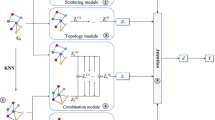Abstract
Graph Convolutional Networks have been widely used for node classification. Since the original data usually contains nonlinear relationships that are difficult to capture and includes noise that leads to the poor performance of the constructed graph representation, the paper proposes a novel Nonlinear Graph Learning-Convolutional Network (NGLCN) based on the kernel method and graph representation learning. Specifically, NGLCN first uses a kernel method to map the original data into kernel space, making the original linearly separable to capture the nonlinear relationship between the data, and then uses a feature selection based on structure information to remove the noisy and redundant feature and constructs a high-quality graph representation, and finally employs a common graph convolutional network to conduct node classification tasks. Experimental results on eight benchmark datasets show that NGLCN outperforms the state-of-the-art traditional graph convolutional networks.




Similar content being viewed by others
References
Scarselli F, Gori M, Tsoi AC, Hagenbuchner M, Monfardini G (2008) The graph neural network model. IEEE Trans Neural Netw 20(1):61–80
Wu Z, Pan S, Chen F, Long G, Zhang C, Yu PS (2021) A comprehensive survey on graph neural networks. IEEE Trans Neural Netw Learn Syst 32(1):4–24
Goyal P, Ferrara E (2017) Graph embedding techniques, applications, and performance: a survey. Knowl Based Syst 151:78–94
Bengio Y, Courville A, Vincent P (2013) Representation learning: a review and new perspectives. IEEE Trans Pattern Anal Mach Intell 35(8):1798–1828
Bruna J, Zaremba W, Szlam A, LeCun Y (2013). Spectral networks and locally connected networks on graphs. arXiv preprint arXiv: 1312.6203, 2013
Defferrard M, Bresson X, Vandergheynst P (2016). Convolutional neural networks on graphs with fast localized spectral filtering. In Advances in neural information processing systems, pages 3844–3852, 2016
Hamilton WL, Ying R , Leskovec J (2017). Inductive representation learning on large graphs. CoRR, abs/1706.02216,
Veličković P, Cucurull G, Casanova A, Romero A, Liò P, Bengio Y (2018). Graph Attention Networks. International Conference on Learning Representations, 2018. accepted as poster
Zhou J, Cui G, Zhang Z, Yang C, Liu Z, Wang L, Li C, Sun M (2018). Graph neural networks: A review of methods and applications. arXiv preprint arXiv: 1812.08434, 2018
Li Q, Han Z, Wu XM (2018). Deeper insights into graph convolutional networks for semi-supervised learning. arXiv preprint arXiv: 1801.07606, 2018
Hu F, Zhu Y, Wu S, Wang L, Tan T (2019). Hierarchical graph convolutional networks for semi-supervised node classification. arXiv preprint arXiv:1902.06667, 2019
Liu Z, Lai Z, Ou W, Zhang K, Zheng R (2020) Structured optimal graph based sparse feature extraction for semi-supervised learning. Signal Process 170:107456
Zhu X, Goldberg AB (2009) Introduction to semi-supervised learning. Synth lect artifi intell mach learn 3(1):1–130
Bhagat S, Cormode G , Muthukrishnan S, (2011). Node classification in social networks. In Social network data analytics, 115–148. Springer,
Farouk Abdel Hady Mohamed, Schwenker Friedhelm (2013) Semi-supervised learning. J Royal Statistical Soc. 49(2):215–239
Kipf TN, Welling M (2016). Semi-supervised classification with graph convolutional networks. arXiv preprint arXiv: 1609.02907, 2016
Shen HT, Zhu X, Zhen Z, Wang SH , Chen YX, Shao JX (2021). Heterogeneous data fusion for predicting mild cognitive impairment conversion. Inf Fus 66:54–63. https://doi.org/10.1109/TNNLS.2020.3009632
Hu R, Zhu X, Zhu Y, Gan J (2020) Robust svm with adaptive graph learning. World Wide Web 23:1945–1968
Zhu X, Zhang S, Zhu Y, Zhu P, Gao Y (2020) Unsupervised spectral feature selection with dynamic hyper-graph learning. IEEE Trans Knowl Data Eng page. https://doi.org/10.1109/TKDE.2020.3017250
Zhou Y, Tian L, Zhu C, Jin X, Sun Y (2020) Video coding optimization for virtual reality 360-degree source. J. Sel. Top Signal Process 14(1):118–129
Depiero F, Trivedi M, Serbin S (1996) Graph matching using a direct classification of node attendance. Pattern Recognit 29(6):1031–1048
Shen HT, Zhu Y, Zheng W, Zhu X (2020) Half-quadratic minimization for unsupervised feature selection on incomplete data. IEEE transac neural netw learn syst page. https://doi.org/10.1109/TNNLS.2020.3009632
Hu R, Zhu X, Cheng D, He W, Yan Y, Song J, Zhang S (2017) Graph self-representation method for unsupervised feature selection. Neurocomputing 220:130–137
Zhu X, Song B, Shi F, Chen Y, Hu R, Gan J, Zhang W, Li M, Wang L, Gao Y, Shan F, Shen D (2021) Joint prediction and time estimation of covid-19 developing severe symptoms using chest ct scan. Med Image Anal 67:101824
Bai L, Cui L, Wang Y , Yu PS, Hancock ER (2019). Fused lasso for feature selection using structural information. arXiv preprint arXiv:1902.09947
Nie F, Wei Z, Li X (2016). Unsupervised feature selection with structured graph optimization, In Thirtieth AAAI conference on artificial intelligence
Jiang B, Zhang Z, Lin D, Tang J, Luo B (2020). Semi-supervised learning with graph learning-convolutional networks. In 2019 IEEE/CVF Conference on Computer Vision and Pattern Recognition (CVPR), 2020
Cai D, He X, Han J (2005) Document clustering using locality preserving indexing. IEEE Trans Knowl Data Eng 17(12):1624–1637
He X, Cai X, Liu H, Ma WY, (2004). Locality preserving indexing for document representation. In Proceedings of the 27th annual international ACM SIGIR conference on Research and development in information retrieval, pages 96–103
Aref J (2015) Spectral graph theory. Spectr Theory Appl Linear Oper Block Oper Matrices 1:413–439
Zhu X, Gan J, Lu G, Li J, Zhang S (2020) Spectral clustering via half-quadratic optimization. World Wide Web 23:1969–1988
Chen L, Lu G, Li Y, Li J, Tan M (2020) Local structure preservation for nonlinear clustering. Neural Process Lett 52:1811–1826
Acknowledgements
This work is partially supported by the Key Program of the National Natural Science Foundation of China (Grant No: 61836016), the Natural Science Foundation of China (Grants No: 61876046, 61672176), the Research Fund of Guangxi Key Lab of Multisource Information Mining & Security (18-A-01-01, MIMS18-M-02).
Author information
Authors and Affiliations
Corresponding author
Additional information
Publisher's Note
Springer Nature remains neutral with regard to jurisdictional claims in published maps and institutional affiliations.
Rights and permissions
About this article
Cite this article
Chen, L., Liu, X. & Li, Z. Nonlinear Graph Learning-Convolutional Networks for Node Classification. Neural Process Lett 54, 2727–2736 (2022). https://doi.org/10.1007/s11063-021-10478-x
Accepted:
Published:
Issue Date:
DOI: https://doi.org/10.1007/s11063-021-10478-x




